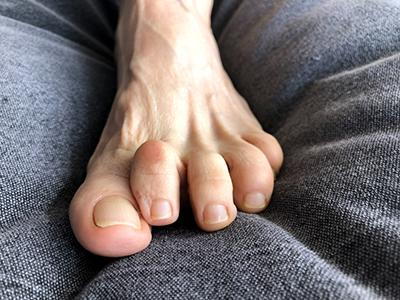Hammertoes and Their Causes

- posted: Aug. 17, 2022
Discover more about this foot deformity and why it happens.
Bunions always seem to get the spotlight when talking about foot deformities; however, it’s also essential to shed light on hammertoes. This common deformity affects the middle joint of the smaller toes. When this joint is impacted, it causes the toes to bend downward. Wondering if you may be at risk for hammertoes? Here’s what you should know,
What Can Lead to a Hammertoe?
It’s important to figure out what can cause a hammertoe to develop so you can do your best to avoid certain habits or practices that could increase your risk. Some risk factors for hammertoes include,
- A family history of hammertoes
- Wearing tight or pointed shoes
- Wearing shoes that are too small
- Dealing with bunions, corns and calluses
- Arthritis
- Injury or trauma to a toe
One of the easiest ways to avoid developing a hammertoe is to wear the proper shoes. This means avoiding shoes that are too small, which forces toes to curl under or bunch up. Wearing poorly fitted shoes can also make bunions, blisters and other foot problems more likely to occur, making developing hammertoes more likely.
What Are the Symptoms of a Hammertoe?
Those with more mild symptoms may only notice the presence of a corn or callus, and the toe will be bent down. You may notice some pain when walking or trying to move the affected toe. Those with more severe symptoms may have trouble walking or may not be able to move their toes. The affected toes will also look claw-like in nature.
How Is a Hammertoe Treated?
If you suffer from only mild hammertoe symptoms, then the number one recommendation your podiatrist may make is to change your footwear. Avoid shoes with high arms, pointed toes, or shoes that are too tight and push toes into a bunched position. You can also opt for shoe inserts and orthotics to take pressure off certain parts of your foot while walking. This can also reduce pain and discomfort while moving.
Also, talk to your podiatrist about stretching exercises you can do from the comfort of your home daily to reduce hammertoe-related symptoms. This can also help to reposition the toe over time.
If you have more severe symptoms and other treatments aren’t improving your condition, you may need surgery to help realign the toe. Surgery for hammertoes is usually performed as an outpatient procedure.

- posted: Aug. 17, 2022
Discover more about this foot deformity and why it happens.
Bunions always seem to get the spotlight when talking about foot deformities; however, it’s also essential to shed light on hammertoes. This common deformity affects the middle joint of the smaller toes. When this joint is impacted, it causes the toes to bend downward. Wondering if you may be at risk for hammertoes? Here’s what you should know,
What Can Lead to a Hammertoe?
It’s important to figure out what can cause a hammertoe to develop so you can do your best to avoid certain habits or practices that could increase your risk. Some risk factors for hammertoes include,
- A family history of hammertoes
- Wearing tight or pointed shoes
- Wearing shoes that are too small
- Dealing with bunions, corns and calluses
- Arthritis
- Injury or trauma to a toe
One of the easiest ways to avoid developing a hammertoe is to wear the proper shoes. This means avoiding shoes that are too small, which forces toes to curl under or bunch up. Wearing poorly fitted shoes can also make bunions, blisters and other foot problems more likely to occur, making developing hammertoes more likely.
What Are the Symptoms of a Hammertoe?
Those with more mild symptoms may only notice the presence of a corn or callus, and the toe will be bent down. You may notice some pain when walking or trying to move the affected toe. Those with more severe symptoms may have trouble walking or may not be able to move their toes. The affected toes will also look claw-like in nature.
How Is a Hammertoe Treated?
If you suffer from only mild hammertoe symptoms, then the number one recommendation your podiatrist may make is to change your footwear. Avoid shoes with high arms, pointed toes, or shoes that are too tight and push toes into a bunched position. You can also opt for shoe inserts and orthotics to take pressure off certain parts of your foot while walking. This can also reduce pain and discomfort while moving.
Also, talk to your podiatrist about stretching exercises you can do from the comfort of your home daily to reduce hammertoe-related symptoms. This can also help to reposition the toe over time.
If you have more severe symptoms and other treatments aren’t improving your condition, you may need surgery to help realign the toe. Surgery for hammertoes is usually performed as an outpatient procedure.
